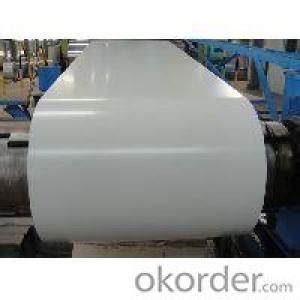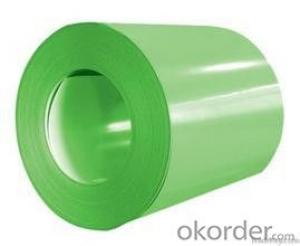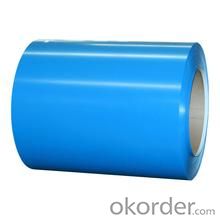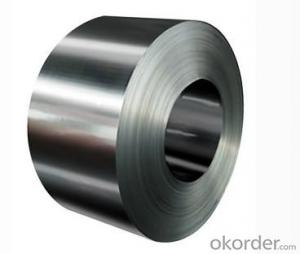Prepainted galvanized rolled Steel Coil-DX51D
- Loading Port:
- Tianjin
- Payment Terms:
- TT OR LC
- Min Order Qty:
- 100 m.t.
- Supply Capability:
- 500000 m.t./month
OKorder Service Pledge
OKorder Financial Service
You Might Also Like
Description:
Prepainted Galvanized Steel usually refers to have substrateprocessed with surface processed and coated then(roller coated )or bonded organic thin film and baked, and it is able to be processed tofinal prodevtion .
PrepaintedGalvanized Steel qualified with excellent decorative ,formability ,corrosionresistance ,coating adhesion ,can keep for a long time as well as maintainfresh color .For color coated steel sheet can obtain good economicbenefit by steel belt wood ,efficient in construction and save energy ,preventpollution etc.Which is an ideal material;for manufacturing board.
Technical Data:
Yield Strength | (Mpa) 280-320 |
Tensile Strength | (Mpa) 340-390 |
Elongation | 20%-30% |
Reverse Impact | 9J |
T-bending | ≥2T |
Pencil Hardness | ≥2H |
Duration Of Salt Spray Test | 500 H |
Bending At 180 Degree | No crack, purling and fraction |
Applications:
It can be widely used in transportation, light industry, civil usage and farming. It is also the perfect building material in construction for making steel roofing,insulation panel, corrugate sheet, facade wall,shutters,T-bar and home appliance.
Packaging & Delivery:
The packing of coils consists of anti-damp paper, PVC film, hardboard paper, steel box, strapped with steel strips, fitted with locks and edge protectors and guarantees the optimal condition of the delivered goods. Each coil can be additionally fitted with wooden/steel skids(eye to the side) or wooden pallets(eye to the sky).
Images:

- Q: What is the average tensile strength of a steel coil?
- The average tensile strength of a steel coil can vary depending on the specific grade and type of steel used. However, on average, steel coils tend to have tensile strengths ranging from 300 to 2,000 megapascals (MPa).
- Q: How are steel coils used in the production of storage racks?
- Steel coils are used in the production of storage racks by being uncoiled, cut, and shaped into the required dimensions and components of the racks. These steel coils provide the necessary strength and durability to support heavy loads and ensure the stability and longevity of the storage racks.
- Q: What are the main factors that affect the flatness of steel coils?
- The main factors that affect the flatness of steel coils include the quality and consistency of the incoming raw material, the precision of the rolling process, the tension applied during rolling, the cooling and annealing processes, and the handling and storage of the finished coils.
- Q: How are steel coils used in the production of HVAC ducts?
- Steel coils are an essential component in the production of HVAC ducts. These coils are typically made of galvanized steel, which provides strength, durability, and resistance to corrosion. In the manufacturing process, steel coils are first unwound and flattened to create flat sheets. These sheets are then cut into specific sizes and shapes according to the design and dimensions of the HVAC ducts. The steel coils are often processed through various machines, such as shearing machines, slitting machines, and roll forming machines, to achieve the desired shapes and sizes for the ducts. Once the steel coils are transformed into the appropriate shapes, they are then further processed to add additional features to the ducts. For instance, the coils may undergo bending, folding, or welding processes to create bends, angles, or connections in the ductwork. These processes allow for the customization of the ducts to fit the specific requirements of the HVAC system and the building structure. Furthermore, steel coils play a crucial role in ensuring the strength and integrity of HVAC ducts. The galvanized steel used in the coils provides a protective layer that prevents rust and corrosion, making the ducts more durable and long-lasting. This is especially important as HVAC ducts are often exposed to various environmental factors, such as moisture, temperature changes, and airborne contaminants. Overall, steel coils are a fundamental component in the production of HVAC ducts. They provide the necessary strength, durability, and resistance to corrosion, while also allowing for customization and flexibility in the manufacturing process.
- Q: How are steel coils used in the production of metal ceilings?
- Steel coils are used in the production of metal ceilings as they serve as the raw material. The steel coils are processed and shaped into the desired dimensions and patterns before being installed as ceiling panels.
- Q: How do steel coils contribute to the agricultural machinery industry?
- Due to their versatile and durable nature, steel coils play an essential role in the agricultural machinery industry. They are used in various applications and contribute significantly to improving the efficiency and productivity of agricultural machinery. Manufacturing equipment frames and structures is one primary way steel coils contribute to the agricultural machinery industry. These frames provide the necessary strength and stability to withstand the demanding conditions of agricultural operations. Whether it's tractors, harvesters, or tillers, steel coils are utilized to create robust and rigid frames capable of handling heavy loads, vibrations, and impacts. Moreover, steel coils are vital in fabricating components like plow blades, cultivator tines, and seed drills. These components are crucial for soil preparation, seed planting, and crop maintenance. Steel coils provide the necessary strength and resistance to wear and tear, ensuring these components can endure the rigors of agricultural operations and have a prolonged lifespan. Additionally, steel coils are used in manufacturing hydraulic systems and other moving parts in agricultural machinery. These systems are responsible for powering and controlling various functions such as lifting, lowering, and steering. Steel coils provide the necessary strength and flexibility for these systems to function optimally, ensuring smooth and efficient operation of agricultural machinery. Furthermore, the use of steel coils in the construction of agricultural machinery enhances equipment safety and longevity. Steel is renowned for its excellent resistance to corrosion, rust, and extreme weather conditions. By incorporating steel coils in the manufacturing process, equipment remains durable and reliable even in harsh environments, ultimately reducing maintenance costs and improving the overall lifespan of the machinery. In conclusion, the agricultural machinery industry heavily relies on steel coils. Their versatility, strength, and durability are indispensable for manufacturing equipment frames, components, hydraulic systems, and other moving parts. By utilizing steel coils, the agricultural machinery industry can produce robust and efficient equipment capable of withstanding demanding agricultural operations, improving productivity, enhancing safety, and extending the lifespan of the machinery.
- Q: like, what can steel make?
- buildings bridges automobiles elevators railroads and railroad equipment appliances and many many more. Steel is used almost everywhere. reference: Iron and steel are used widely in the construction of roads, railways, infrastructure, and buildings. Most large modern structures, such as stadiums and skyscrapers, bridges, and airports, are supported by a steel skeleton. Even those with a concrete structure will employ steel for reinforcing. In addition to widespread use in major appliances and cars (Despite growth in usage of aluminium, it is still the main material for car bodies.), steel is used in a variety of other construction-related applications, such as bolts, nails, and screws.[66] Other common applications include shipbuilding, pipeline transport, mining, offshore construction, pipeline transport, aerospace, white goods (e.g. washing machines), heavy equipment (e.g. bulldozers), office furniture, steel wool, tools, and armour in the form of personal vests or vehicle armour (better known as rolled homogeneous armour in this role). .
- Q: How are steel coils used in the production of industrial shelving?
- Steel coils are used in the production of industrial shelving as they are typically cut and shaped into various components, such as uprights, beams, and braces, which are then assembled to create sturdy and durable shelving units. The coils provide the necessary strength and stability required to support heavy loads and withstand the demands of an industrial environment.
- Q: I just bought a dpms ar15 and it says if I shoot steel cases (laquer coated) or foreign ammo it voids the warranty. But before I knew this I bought 200 rounds of Russian steel cased anmo. Think I should just shoot there two hundred and not buy anymore? Some people say all they shoot is steel cased ammo and have no problemAny advice is appreciated
- steel case does not cause additional wear to the gun's chamber when compared to brass case. many tests has been done and precise measurements taken, this myth has been proven false. lacquer coating can cause issues because it can melt and cool, and cause jams. this is easily remedied with a chamber brush and some solvent.. However, steel jacket causes problems. Steel is harder than copper, it does not deform as easily so it causes more wear to the barrel as compared to copper or brass. The rate is around 10-25%, inreasing if you hoot rapidly instead of slowly. more shooting = hotter barrel = faster wear. It's the same with copper/brass jackets, but steel jacketed always wears more than softer metals. TulAmmo (or tula) is particular is so cheaply made they don't have enough copper/brass wash on the bullet to survive firing, after a few inches of travel it's steel on steel contact in the bore and it can ruin a gun barrel very quickly. But... there is one exception. if your gun comes with a chrome-lined bore that is standard for most AR's , shoot all the cheap junk you can buy. chrome-lined steel is 2X as hard as plain steel. crappy tula .223 will not cause more harm to a chrome-lined bore more than brass or copper jacketed bullets.
- Q: Steel is strong in both tension and compression. Concrete is only strong in compression, and is very fragile in tension. Plus, concrete is heavy--a huge drawback in, say, a bridge deck. And its fairly expensive. And it hides the condition of the steel embedded within it. So what does it bring to the table? Why use it at all?
- Pre stressed concrete is held in compression by the steel cables within.
Send your message to us
Prepainted galvanized rolled Steel Coil-DX51D
- Loading Port:
- Tianjin
- Payment Terms:
- TT OR LC
- Min Order Qty:
- 100 m.t.
- Supply Capability:
- 500000 m.t./month
OKorder Service Pledge
OKorder Financial Service
Similar products
Hot products
Hot Searches
Related keywords




























